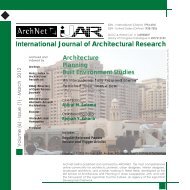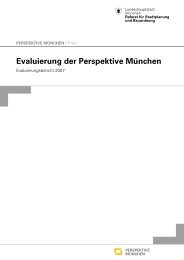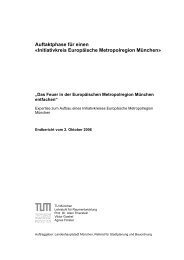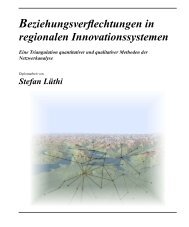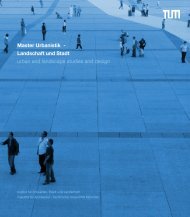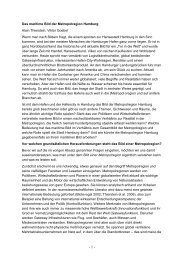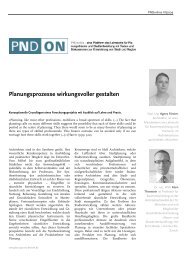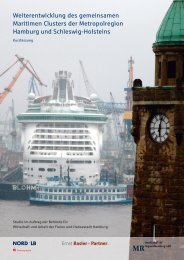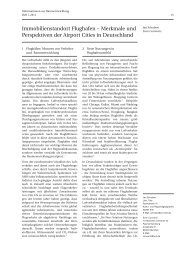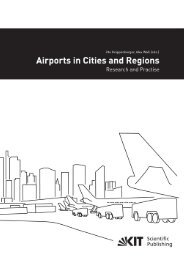Urban Development in Munich - Raumentwicklung TUM
Urban Development in Munich - Raumentwicklung TUM
Urban Development in Munich - Raumentwicklung TUM
Create successful ePaper yourself
Turn your PDF publications into a flip-book with our unique Google optimized e-Paper software.
Dr A.Thierste<strong>in</strong>, S.Reiss-Schmidt: <strong>Urban</strong> <strong>Development</strong> Management <strong>in</strong> <strong>Munich</strong>, Germany<br />
44th ISOCARP Congress 2008<br />
Figure 2 left: Preferred settlement areas (red), situated at railway-stops (S-Bahn) accord<strong>in</strong>g Regional<br />
Plan; right: <strong>Development</strong> of traffic (rides) 2000 - 2015 – city (yellow) and surround<strong>in</strong>g region (grey),<br />
scenario: <strong>Munich</strong> traffic development plan (source: City of <strong>Munich</strong>)<br />
The city recognises to be function<strong>in</strong>g only with<strong>in</strong> a wider city-region delimitation - the megacity<br />
region of <strong>Munich</strong>. Thus be<strong>in</strong>g the primary city, <strong>Munich</strong> assumes responsibility to susta<strong>in</strong>ably<br />
deal with its resources <strong>in</strong> order not to foster unwanted urban sprawl and <strong>in</strong>creas<strong>in</strong>g mobility<br />
with private cars. Prevent<strong>in</strong>g <strong>in</strong>creas<strong>in</strong>g CO2-emissions fac<strong>in</strong>g accelerated climate<br />
change and even the <strong>in</strong>creas<strong>in</strong>g costs of commut<strong>in</strong>g-mobility and <strong>in</strong>frastructure for a suburbanised,<br />
low-density settlement strategy call for action <strong>in</strong> cooperation of city and regional<br />
plann<strong>in</strong>g authorities.<br />
On the local level <strong>Munich</strong> has a very elaborated <strong>in</strong>tegrated development concept, the “PER-<br />
SPECTIVE MUNICH”, which follows the pr<strong>in</strong>ciples of “susta<strong>in</strong>ability and urbanity”.<br />
Economic prosperity, regional cooperation, social balance and equity, <strong>in</strong>ner development of<br />
the city <strong>in</strong>stead of sprawl, and a susta<strong>in</strong>able mobility for all citizens are some of its guidel<strong>in</strong>es.<br />
The city‟s strategic guidel<strong>in</strong>e for spatial development is labelled “compact, urban, green”.<br />
In l<strong>in</strong>e with its <strong>in</strong>tegrated, long-term-approach - which has a tradition of 45 years of <strong>in</strong>tegrated<br />
development plann<strong>in</strong>g – the guid<strong>in</strong>g pr<strong>in</strong>ciples and strategies of PERSPECTIVE MUNICH<br />
centre on the city as a whole, as well as on the surround<strong>in</strong>g region. With<strong>in</strong> the framework of<br />
path f<strong>in</strong>d<strong>in</strong>g-projects and local or sectoral concepts as well as action programmes – for <strong>in</strong>stance<br />
for traffic development or assignment of hous<strong>in</strong>g and retail uses – these pr<strong>in</strong>ciples are<br />
then given concrete form. Key to countervail unwanted urban sprawl is two transversal<br />
strategies of the PERSPECTIVE MUNICH: “<strong>in</strong>ternal expansion” and “urban, compact, green”.<br />
In the <strong>in</strong>terest of susta<strong>in</strong>ability, the use of previously undeveloped, unsealed land must be<br />
sharply reduced when new residential areas are be<strong>in</strong>g developed. The focus of <strong>in</strong>ternal expansion<br />
lies on concepts designed to reuse and restructure exist<strong>in</strong>g build up areas fallen out<br />
of their use (“Flächenkreislaufwirtschaft”) - for <strong>in</strong>stance former <strong>in</strong>dustrial or railway land and<br />
former military barracks that lie with<strong>in</strong> city-limits.<br />
As a result of the privatisation of the federal railway and postal as well as telecommunication<br />
services and the reduction of military force – both of the German and the Allied forces - at the<br />
beg<strong>in</strong>n<strong>in</strong>g of the 1990s, <strong>Munich</strong> experienced a „w<strong>in</strong>dfall‟ ga<strong>in</strong> <strong>in</strong> the form of a huge amount of<br />
<strong>in</strong>ner city development resources – without reduc<strong>in</strong>g scarce open space. More than 60‟000<br />
hous<strong>in</strong>g dwell<strong>in</strong>gs could be realised on these <strong>in</strong>ternal expansion sites. For most users it is<br />
very attractive to concentrate activities on these restructur<strong>in</strong>g areas s<strong>in</strong>ce they are embedded<br />
<strong>in</strong> exist<strong>in</strong>g <strong>in</strong>frastructure, available and partly reusable build<strong>in</strong>gs and mostly have rather good<br />
<strong>in</strong>tegration <strong>in</strong>to the public transport network. The already exist<strong>in</strong>g urban context offers the<br />
chance to ameliorate neighbour<strong>in</strong>g areas by new hous<strong>in</strong>g, more open space and a better social<br />
<strong>in</strong>frastructure.<br />
3



